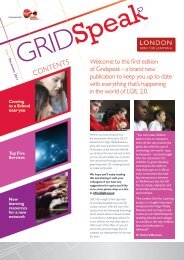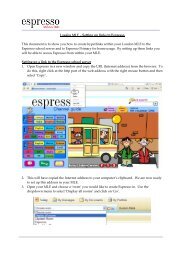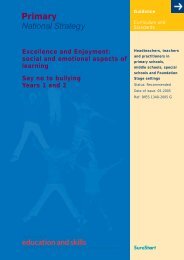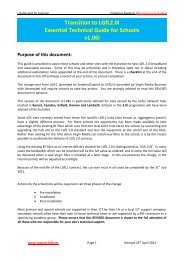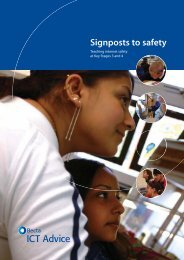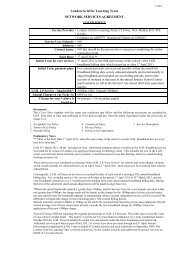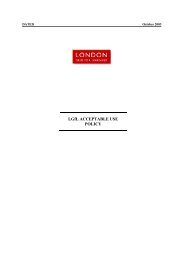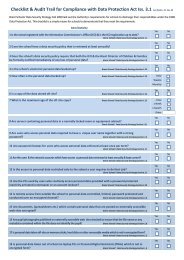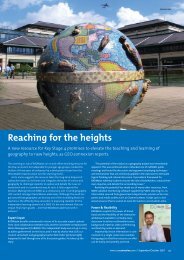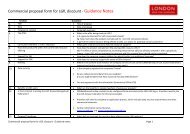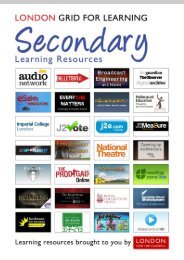RESEARCH AND POLICY REVIEW2.4 CONNECTING HOME AND SCHOOL CULTURES22.4 CONNECTINGHOME AND SCHOOLCULTURESParents’ involvement in children’s <strong>school</strong>lives and learning is a crucial factor in <strong>the</strong><strong>relationship</strong> between <strong>home</strong> and <strong>school</strong>.However to more fully understand <strong>the</strong><strong>relationship</strong> between <strong>home</strong> and <strong>school</strong> and<strong>the</strong> context and constraints on parents’engagement with children’s learning, weneed to consider how <strong>the</strong> cultures of <strong>home</strong>and <strong>school</strong> relate to one ano<strong>the</strong>r. Home is notonly a physical place, but a social constructthat encompasses <strong>the</strong> family’s routines andstructures. So <strong>home</strong>-<strong>school</strong> <strong>relationship</strong>s arenot just about linking one geographic settingwith ano<strong>the</strong>r, but about negotiating <strong>the</strong>different social and cultural constructs of<strong>home</strong> and <strong>school</strong>.Learning at <strong>school</strong> can be seen as increasinglydisconnected from children’s lives, culturesand learning experiences outside <strong>school</strong>. Thiscan be especially true for children whose <strong>home</strong>cultures are particularly different to <strong>school</strong>cultures, including working class familiesand families from some ethnic minoritybackgrounds 41 . If education aims to helpchildren develop and take up responsibilitieswithin <strong>the</strong>ir community, and to be perceivedby children as meaningful, <strong>the</strong>n it needs tohave some relevance to children’s lives outside<strong>school</strong> 42 . As well as connecting to children’slives as <strong>the</strong>y experience <strong>the</strong>m, education alsoneeds to connect to children’s aspirations for<strong>the</strong>ir future lives, and many would argue thateducation <strong>the</strong>refore also needs to offer childrenhigher and broader aspirations for <strong>the</strong>ir futures<strong>the</strong>n <strong>the</strong>y bring with <strong>the</strong>m to <strong>school</strong> 43 . However,if <strong>the</strong>se extended aspirations are completelydisconnected from children’s current lives, <strong>the</strong>ymay be seen as distant and unachievable.This section <strong>the</strong>refore explores <strong>the</strong> nature of<strong>the</strong> connections between children’s <strong>home</strong> and<strong>school</strong> cultures in order to provide a biggerpicture of <strong>the</strong> relative contributions of, and<strong>relationship</strong> between <strong>home</strong> and <strong>school</strong>.Transitions between <strong>home</strong> and<strong>school</strong> culturesChildren’s transitions from <strong>home</strong> to <strong>school</strong>involve a change in identity from <strong>the</strong> child at<strong>home</strong> to <strong>the</strong> pupil in <strong>the</strong> classroom. There maybe continuity or discontinuity between <strong>the</strong>setwo identities depending on how appropriatechildren’s behaviour from one setting isin ano<strong>the</strong>r, and <strong>the</strong> consistency of adults’responses to children’s behaviour. When <strong>the</strong>reis discontinuity, children face a task of adaptingto <strong>the</strong> new contexts <strong>the</strong>y are faced with 44 .Particular ways of knowing and learning areembedded in social and cultural practices.When <strong>the</strong> practices of ‘knowing’ in <strong>home</strong> and<strong>school</strong> are very different, learners’ successfulexperiences of learning at <strong>home</strong> may notfacilitate learning at <strong>school</strong>. For example, inAustralia, Aboriginal practices of knowingare more communal, and children can find<strong>the</strong>mselves told off for ‘cheating’ when helpingeach o<strong>the</strong>r in <strong>the</strong> more individualised learningparadigm of <strong>the</strong> classroom 45 . However,attempts to teach parents to interact with <strong>the</strong>irchildren in more ‘<strong>school</strong>-like’ ways can giverise to conflict and tension that can actuallyreinforce ra<strong>the</strong>r than overcome inequalities 46 .2441. Maddock, M (2006). Children’s personal learning agendas at <strong>home</strong>. Cambridge Journal of Education, 36,2: 153-16942. Article 29 of <strong>the</strong> UN Convention on <strong>the</strong> Rights of <strong>the</strong> Child specifies that children should experience <strong>the</strong> kind of education whichhelps <strong>the</strong>m develop and take up responsibilities within <strong>the</strong> community. See www.unicef.org/crc/files/Rights_overview.pdf.43. See, for example, Cabinet Office (2008). Aspiration and attainment amongst young people in deprived communities: Analysis anddiscussion paper. Available from: www.cabinetoffice.gov.uk/social_exclusion_task_force/short_studies/aspirations.aspx44. Lam, MS and Pollard, A (2006). A conceptual framework for understanding children as agents in <strong>the</strong> transition from <strong>home</strong> tokindergarten. Early Years, 26,2: 123-14145. Maddock, M (2006). Children’s personal learning agendas at <strong>home</strong>. Cambridge Journal of Education, 36,2: 153-16946. Alldred, P, David, M and Edwards, R (2002). Minding <strong>the</strong> gap: Children and young people negotiating relations between <strong>home</strong> and<strong>school</strong>. In R Edwards (ed), Children, Home and School: Regulation, Autonomy or Connection? London and New York: Routledge: 106-120.
Third spaces and funds of knowledgeRa<strong>the</strong>r than attempt to integrate <strong>home</strong> and<strong>school</strong> cultures or encourage <strong>home</strong>s to adopt<strong>school</strong> cultures, third space <strong>the</strong>ories have beenapplied to attempts to create spaces in whichaspects of <strong>the</strong> two different cultures of <strong>school</strong>and <strong>home</strong> can come into ‘conversation’ withone ano<strong>the</strong>r 47 . It is hoped that this approachcan make <strong>school</strong> learning experiences moremeaningful and accessible to children byconnecting <strong>the</strong>m with <strong>the</strong> cultures and contextschildren are familiar with and interested inoutside <strong>school</strong> 48 .Third space <strong>the</strong>ories see children as possessing‘funds of knowledge’, acquired throughparticipation in <strong>the</strong> daily life of <strong>the</strong>ir familiesand communities, and essential for everydayfunctioning and wellbeing within thosecommunities. Because different communitieshave different social and cultural practices, <strong>the</strong>ywill give rise to different funds of knowledge.Teachers also draw on <strong>the</strong> funds of knowledge<strong>the</strong>y develop through participation in <strong>the</strong>irown communities and professional practice 49 .Children’s funds of knowledge, developedwithin <strong>the</strong>ir families and communities, can bemarginalised within a <strong>school</strong> discourse. Theidea of ‘third spaces’ describes <strong>the</strong> merging of<strong>the</strong> informal ‘first space’ of <strong>home</strong>, communityand peers with <strong>the</strong> more formal ‘second space’of <strong>school</strong> or work. Integrating <strong>the</strong> differentfunds of knowledge from <strong>school</strong> and <strong>home</strong> toform a third space that values both discoursescan be seen as helping children successfullynavigate between and build bridges from<strong>the</strong> sometimes marginalised knowledgepractices of children’s <strong>home</strong>s to <strong>the</strong> moreconventional academic knowledge of <strong>school</strong>.This perspective sees children as having accessto multiple funds of knowledge from <strong>home</strong> and<strong>school</strong> that <strong>the</strong>y can draw on in <strong>the</strong>ir learning– and that by helping children draw on all <strong>the</strong>resources at <strong>the</strong>ir disposal, <strong>the</strong>y are likely to bemore successful learners.By bringing <strong>the</strong> different funds of knowledge of<strong>home</strong> and <strong>school</strong> into ‘conversation’ with oneano<strong>the</strong>r, both <strong>home</strong> and <strong>school</strong> knowledges canbe challenged and reshaped, potentially givingrise to new knowledges. Children, as <strong>the</strong>y getolder and develop more independence, can beseen as carving out <strong>the</strong>ir own peer culturalspaces between <strong>the</strong> more settled spaces of<strong>home</strong> and <strong>school</strong>, for example hanging outtoge<strong>the</strong>r outside or online. Digital technologiesin fact may offer opportunities for children tocreate <strong>the</strong>ir own virtual third spaces that cantravel between <strong>home</strong> and <strong>school</strong> and where<strong>the</strong>y can draw on and reshape <strong>the</strong>ir funds ofknowledge from both <strong>home</strong> and <strong>school</strong> 50 .In a recent study, some young children’semerging conceptions of <strong>the</strong>mselves as readersgenerated at <strong>home</strong> – as people who enjoybooks, can understand and make meaningfrom a range of texts including pictures,websites and games – were undermined by<strong>the</strong>ir perception that being a reader in <strong>school</strong>was about being able to decode printed words.Some children were able to bring toge<strong>the</strong>raspects of both <strong>the</strong>ir <strong>home</strong> and <strong>school</strong>perceptions of being a reader that reshapedboth <strong>the</strong>ir <strong>school</strong> reading practices and <strong>the</strong>reading practices of <strong>the</strong>ir everyday lives,generating <strong>the</strong> new knowledge and third spacedescribed above. However, o<strong>the</strong>r childrenadopted what <strong>the</strong>y perceived to be <strong>the</strong> <strong>school</strong>’sdefinition of being a reader, and relinquished<strong>the</strong> idea that <strong>the</strong>ir <strong>home</strong> reading practices werevalid 51 . These same arguments are likely to alsoapply to children’s conceptions of <strong>the</strong>mselvesas ‘learners’, with educators needing tofacilitate space in <strong>school</strong> for children’s ownideas of what it is to be a learner to coexist with<strong>school</strong> discourses.CHAPTER RESEARCH TITTLE AND POLICY HERE REVIEWCHAPTER 2.4 CONNECTING SUB-TITTLE HOME HERE AND SCHOOL CULTURES2 ?47. Levy, R (2008). ‘Third spaces’ are interesting places: applying ‘third space <strong>the</strong>ory’ to nursery-aged children’s constructions of<strong>the</strong>mselves as readers. Journal of Early Childhood Literacy, 8,1: 43-6648. For two examples of projects that attempt to create such third spaces, see <strong>the</strong> Home School Knowledge Exchange project atwww.tlrp.org/proj/phase11/phase2e.html49. For more discussion of <strong>the</strong> concept of Funds of Knowledge see Moll, L, and Greenberg, J (1990). Creating zones of possibilities:Combining social contexts for instruction. In L Moll, Vygotsky and Education, 319-348. Cambridge: Cambridge University Press. For itsapplication in a UK educational context see M Hughes and A Pollard (eds) (2006). Educational Review (Special Issue on <strong>the</strong> Home-School Knowledge Exchange Project), 58,4: 385-39550. For more discussion on third spaces, particularly with reference to literacy practices of <strong>home</strong> and <strong>school</strong> see Moje, EB,Ciechanowski, KM, Kramer, K, Ellis, L, Carrillo, R, Collazo, T et al (2004). Working toward third space in content area literacy: anexamination of everyday funds of knowledge and discourse. Reading Research Quarterly, 39,1: 38-70. Retrieved fromwww.jstor.org/stable/4151759. In UK Family Learning context, Pahl, K, and Kelly, S (2005). Family literacy as a third space between<strong>home</strong> and <strong>school</strong>: some case studies of practice. Literacy, 39,2: 91-651. Levy, R (2008). ‘Third spaces’ are interesting places: applying ‘third space <strong>the</strong>ory’ to nursery-aged children’s constructions of<strong>the</strong>mselves as readers. Journal of Early Childhood Literacy, 8,1: 43-6625



